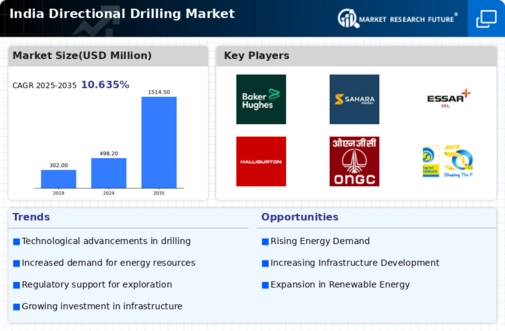The directional drilling market in India is characterized by a competitive landscape that is increasingly shaped by technological advancements and strategic partnerships. Key growth drivers include the rising demand for efficient drilling techniques, the need for enhanced resource recovery, and the ongoing exploration activities in both onshore and offshore sectors. Major players such as Schlumberger (US), Halliburton (US), and Baker Hughes (US) are at the forefront, focusing on innovation and digital transformation to maintain their competitive edge. Their strategies, which include investments in advanced drilling technologies and collaborations with local firms, collectively enhance the market's dynamism and foster a more competitive environment.
In terms of business tactics, companies are increasingly localizing manufacturing and optimizing supply chains to reduce operational costs and improve service delivery. The market structure appears moderately fragmented, with several key players exerting considerable influence. This fragmentation allows for a variety of competitive strategies, as companies seek to differentiate themselves through technological advancements and customer-centric solutions.
In October 2025, Schlumberger (US) announced a partnership with a leading Indian energy firm to develop a new suite of digital drilling solutions aimed at improving operational efficiency. This strategic move is likely to enhance Schlumberger's market presence in India, as it aligns with the growing trend towards digitalization in the energy sector. By leveraging local expertise, Schlumberger may also optimize its service offerings to better meet the specific needs of Indian operators.
In September 2025, Halliburton (US) launched a new directional drilling service that integrates artificial intelligence (AI) to optimize drilling parameters in real-time. This innovation is expected to significantly reduce drilling times and costs, thereby providing a competitive advantage in a market where efficiency is paramount. The integration of AI into their services reflects Halliburton's commitment to staying at the forefront of technological advancements in the industry.
In August 2025, Baker Hughes (US) expanded its operations in India by establishing a new training center focused on advanced drilling techniques. This initiative not only aims to enhance local workforce skills but also positions Baker Hughes as a leader in knowledge transfer within the region. By investing in human capital, the company is likely to strengthen its long-term competitive position in the Indian market.
As of November 2025, current trends in the directional drilling market are heavily influenced by digitalization, sustainability initiatives, and the integration of AI technologies. Strategic alliances are becoming increasingly important, as companies recognize the value of collaboration in driving innovation and enhancing service offerings. Looking ahead, competitive differentiation is expected to evolve, with a notable shift from price-based competition towards a focus on technological innovation, reliability in supply chains, and sustainable practices. This transition may redefine the competitive landscape, compelling companies to adapt and innovate continuously.






















Leave a Comment